coolant CHEVROLET TRACKER 1993 User Guide
[x] Cancel search | Manufacturer: CHEVROLET, Model Year: 1993, Model line: TRACKER, Model: CHEVROLET TRACKER 1993Pages: 339, PDF Size: 15.75 MB
Page 223 of 339
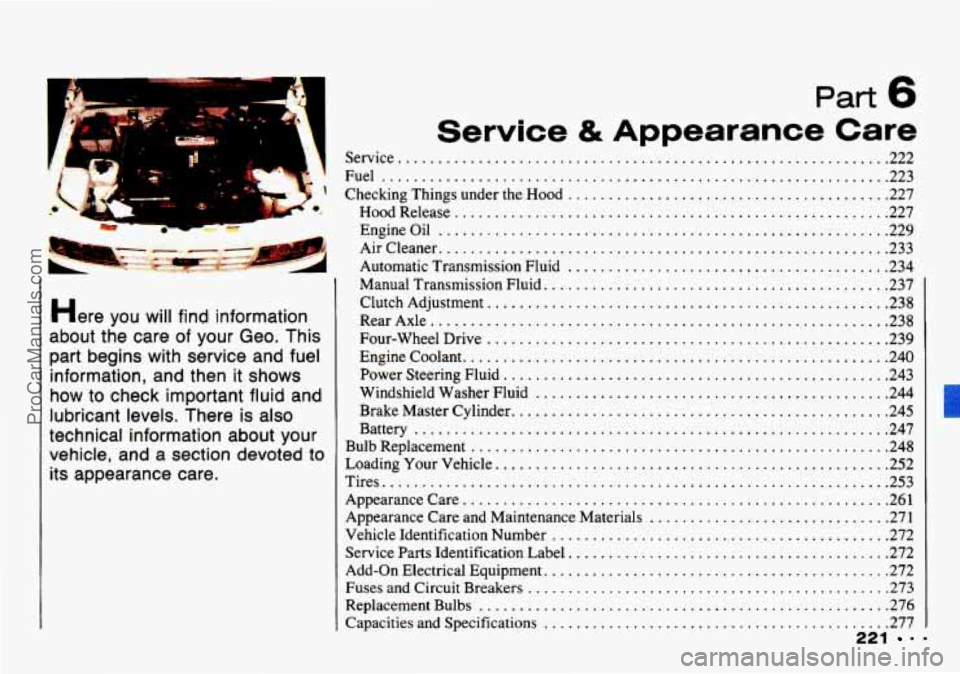
Part 6
Here you wit1 find information
about the care of your Geo
. This
part begins with service and fuel
information. and then it shows
how to check important fluid and
lubricant levels
. There is also
technical information about your
vehicle. and
a section devoted to
its appearance care
.
ii iervice & Appearance Care
Service ............................................................. 222
Fuel ............................................................... 223
Checking Things under the Hood ........................................ 227 .
HoodRelease 227
Engineoil ........................................................ 229
Aircleaner ........................................................ 233
Automatic Transmission Fluid ........................................ 234
Manual Transmission Fluid ........................................... 237
Clutch Adjustment .................................................. 238
RearAxle ......................................................... 238
Four-WheelDrive .................................................. 239
Enginecoolant ..................................................... 240
Power Steering Fluid ................................................ 243
Windshield Washer Fluid ............................................ 244
Brake Master Cylinder ............................................... 245
Battery ........................................................... 247
Bulb Replacement .................................................... 248
LoadingYourVehicle ................................................. 252
Tires ............................................................... 253
Appearancecare ..................................................... 261
Appearance Care and Maintenance Materials .............................. 271
Vehicle Identification Number .......................................... 272
Service Parts Identification Label ........................................ 272
Add-on Electrical Equipment ........................................... 272
Fuses and Circuit Breakers ............................................. 273
ReplacementBulbs ................................................... 276
Capacities and Specifications ........................................... 277
221 .
.
......................................................
ProCarManuals.com
Page 230 of 339

Service & Appearance Care
l-
a
I LUU I lV1V
An electric fan under the
hood can start up and injure
you even when the engine is not
running. Keep hands, clothing and
tools away from any underhood
electric
fan. Don't reach through
the grille to release the underhood
lever.
I
7."
When you open the hood, you'll see:
1. Battery
2. Automatic Transmission Dipstick
(Option)
3. Oil Fill Cap
4. Brake Fluid Reservoir
5. Air Cleaner
6. Power Steering Reservoir (Option)
7. Engine Coolant Reservoir
8. Radiator Cap
9. Electric Fan
10. Engine Oil Dipstick
11. Windshield Washer Reservoir
12. Main Fuse Box
CAUTION
A
Things that burn can get on
hot engine parts and start a
fire. These include liquids like
gasoline, oil, coolant, brake fluid,
windshield washer and other
fluids, and plastic or rubber. You
or others could be burned. Be
careful not to drop or spill things
that will burn onto a hot engine.
Before closing the hood, be sure all the
filler caps are on.
... 228
ProCarManuals.com
Page 242 of 339
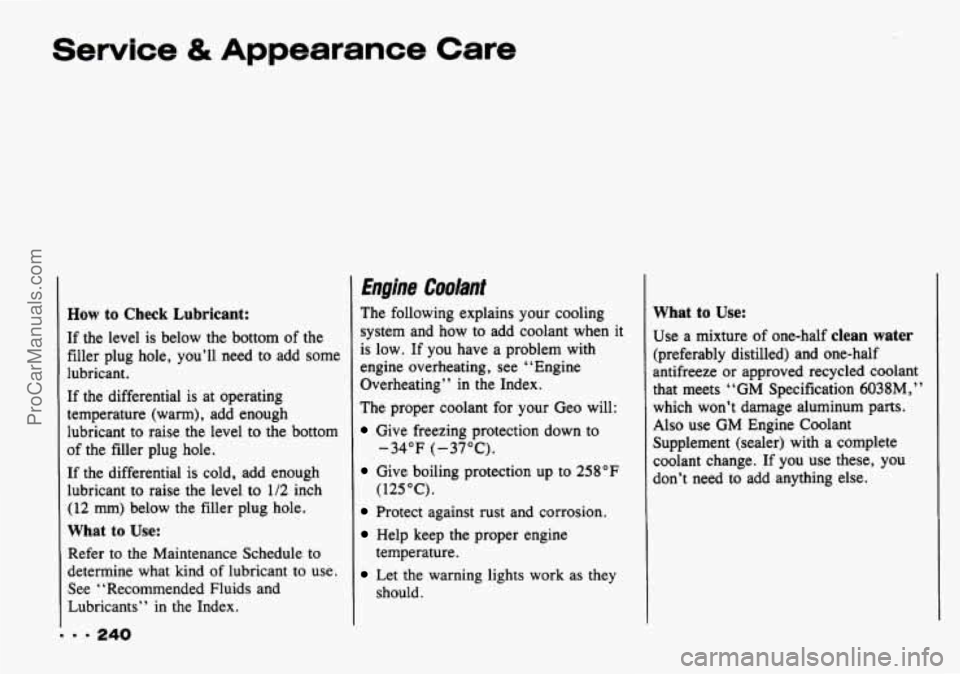
Service & Appearance Care
How to Check Lubricant:
If the level is below the bottom of the
filler plug hole, you’ll need to add some
lubricant.
If the differential is at operating
temperature (warm), add enough
lubricant to raise the level to the bottom
of the filler plug hole.
If the differential
is cold, add enough
lubricant to raise the level to
1/2 inch
(12 mm) below the filler plug hole.
What to Use:
Refer to the Maintenance Schedule to
determine what kind of lubricant to use.
See “Recommended Fluids and
Lubricants” in the Index.
Engine Coolant
The following explains your cooling
system and how to add coolant when it
is low. If you have a problem with
engine overheating, see “Engine
Overheating” in the Index.
The proper coolant for your Geo will:
Give freezing protection down to
Give boiling protection up to 258°F
Protect against rust and corrosion.
Help keep the proper engine
Let the warning lights work as they
-34°F (-37°C).
(125°C).
temperature. should.
What to Use:
Use a mixture of one-half clean water
(preferably distilled) and one-half
antifreeze or approved recycled coolant
that meets “GM Specification 6038M,”
which won’t damage aluminum parts.
Also use GM Engine Coolant
Supplement (sealer) with a complete
coolant change. If you use these, you
don’t need to add anything else.
ProCarManuals.com
Page 243 of 339
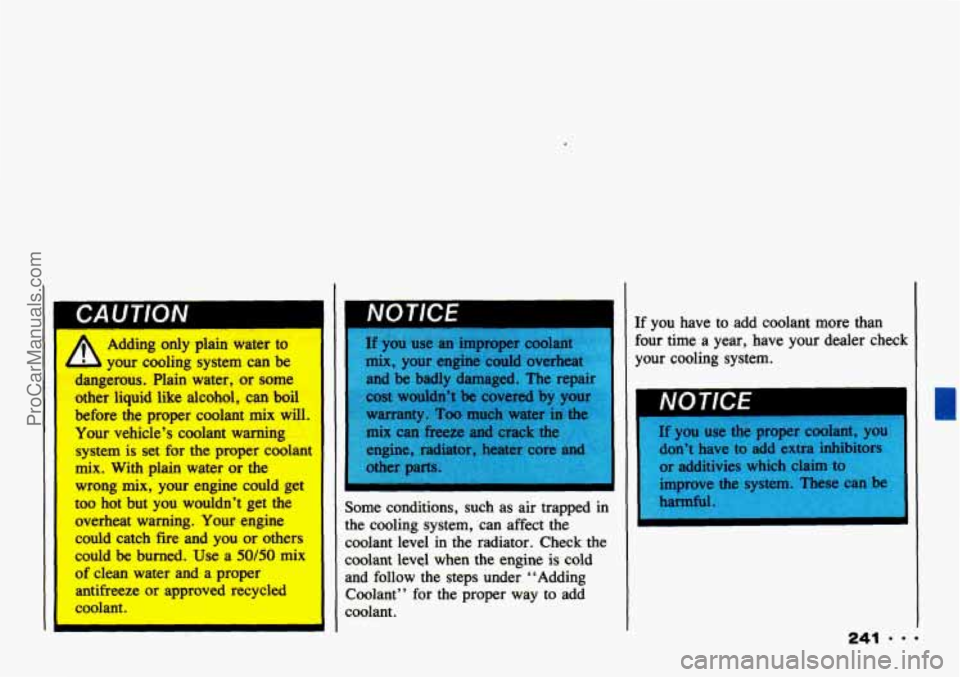
r
Adding only plain water to
b your cooling system can be
dmgemus. Plaia water, or some
other liquid like alcohol, can boil
before the proper coolant mix will.
Your vehicle’s coolant warning
system is set for the proper coolant
mix, With plain water or the
wrong mix, your engine could get
too hot but you wouldn’t get the
overheat warning. Your engine
could catch fire and you or others
could be burned. Use a 50/50 mix
of clean water and a proper
antifreeve or approved recycled
coolant.
I
Some conditions, such as air trapped in
the cooling system, can affect the
coolant level in the radiator. Check the
coolant level when the engine is cold
and follow the steps under ‘‘Adding Coolant” for
the proper way to add
coolant. If you have to add coolant
more than
four time
a year, have your dealer check
your cooling system.
If
you use the proper coolant, you
don’t have to add extra inhibitors
or additivies which claim to
II
241
ProCarManuals.com
Page 244 of 339

Service & Appearance Care
Adding Coolant
To Check Coolant: When your engine
is cold, the coolant level should be
LOW, or a little higher. When your
engine is warm, the level should be up
to
FULL, or a little higher.
To Add Coolant: If you need more
coolant, add the proper mix
at the
coolant recovery tank.
r Turning the radiator pressure
radiator are hot can allow steam
and scalding liquids to blow out
and burn you badly. With the
coolant recovery tank, you will
almost never have to add coolant
at the radiator. Never turn the
radiator pressure cap
- even a
little
- when the engine and
radiator are hot.
cap
when the engine and Add
coolant
mix at the recovery tank,
but be careful not to spill
it.
, You can be burned if you
- L spill coolant on hot engine
parts. Coolant contains ethylene
glycol, and
it will burn if the
engine parts are hot enough. Don't
spill coolant on a hot engine.
ProCarManuals.com
Page 245 of 339
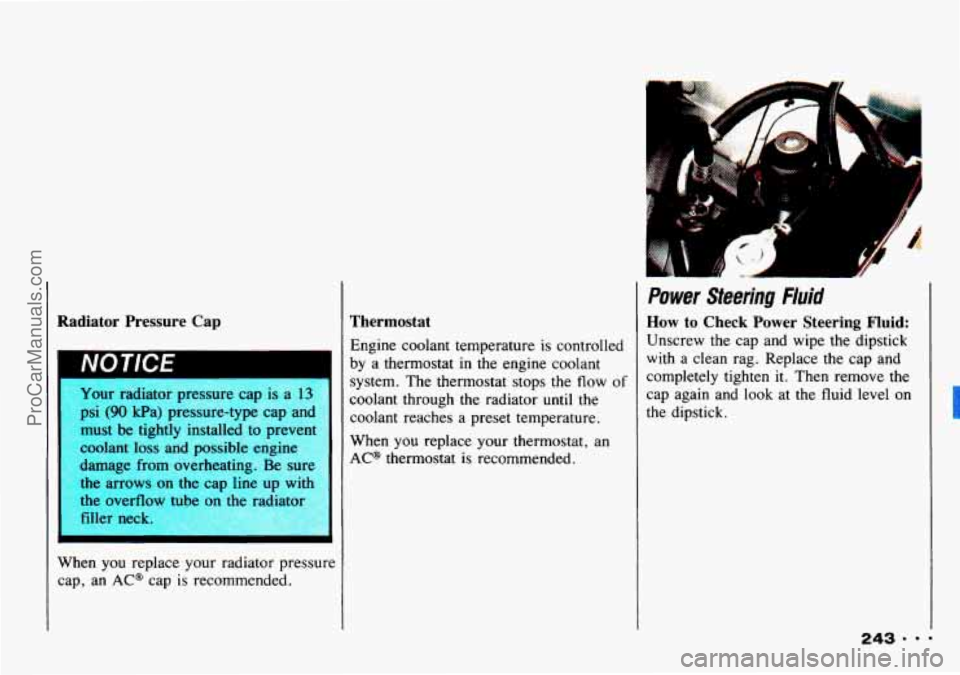
Radiator Pressure Cap
IVU I IIJt
Your radiator pressure cap is a 13
- i (90 kPa) pressure-type cap and
must be tightly installed to prevent
coolant
loss and possible engine
damage from overheating. Be sure
the arrows on the cap line up with
the overflow tube on the radiato
filler neck.
I
When you replace your radiator pressure
cap, an
AC* cap is recommended.
Thermostat
Engine coolant temperature is controlled
by a thermostat in the engine coolant
system. The thermostat stops the flow
of
coolant through the radiator until the
coolant reaches a preset temperature.
When you replace your thermostat, an
AC@ thermostat is recommended.
Power Steering Fluid
How to Check Power Steering Fluid:
Unscrew the cap and wipe the dipstick
with a clean rag. Replace the cap and
completely tighten it. Then remove the
cap again and look at the fluid level on
the dipstick.
ProCarManuals.com
Page 292 of 339
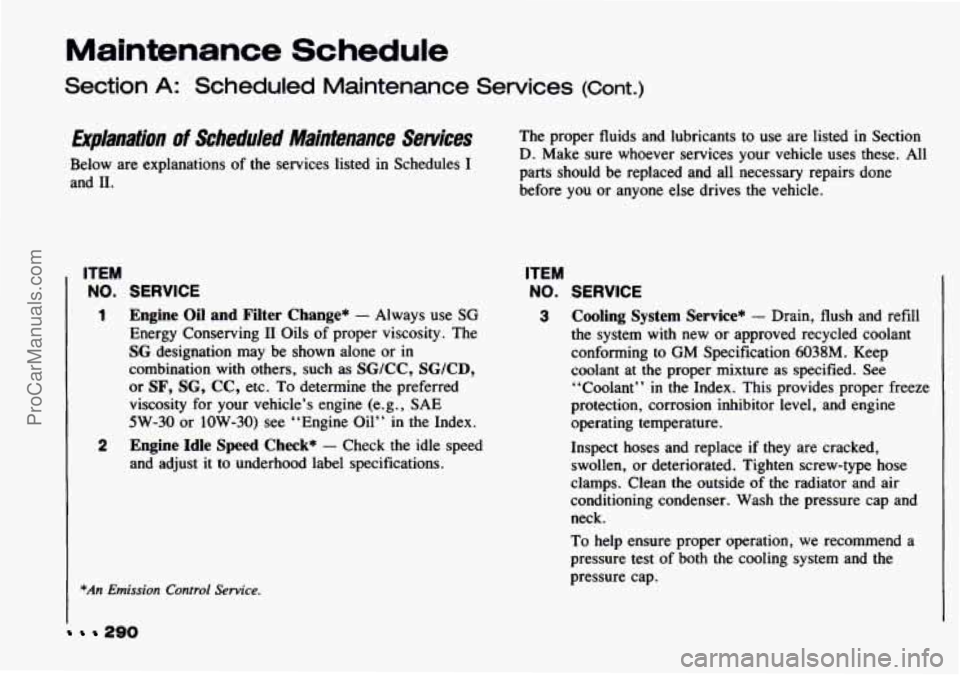
Maintenance Schedule
Section A: Scheduled Maintenance Services (Cont.)
Dplanatiun of Scheduled Maintenance Services
Below are explanations of the services listed in Schedules I
and 11.
290
ITEM
NO.
1
2
SERVICE
Engine Oil and Filter Change* - Always use SG
Energy Conserving I1 Oils of proper viscosity. The
SG designation may be shown alone or in
combination with others, such as SG/CC, SG/CD,
or SF, SG, CC, etc. To determine the preferred
viscosity for your vehicle’s engine (e.g., SAE
5W-30 or 1OW-30) see “Engine Oil’’ in the Index.
Engine Idle Speed Check* - Check the idle speed
and adjust it to underhood label specifications.
*An Emission Control Service.
The proper fluids and lubricants to use are listed in Section
D. Make sure whoever services your vehicle uses these. All
parts should be replaced and all necessary repairs done
before
you or anyone else drives the vehicle.
ITEM
NO. SERVICE
3 Cooling System Service* - Drain, flush and refill
the system with new or approved recycled coolant
conforming to
GM Specification 4038M. Keep
coolant at
the proper mixture as specified. See
“Coolant”
in the Index. This provides proper freeze
protection, corrosion inhibitor level, and engine
operating temperature.
Inspect hoses and replace
if they are cracked,
swollen, or deteriorated. Tighten screw-type hose
clamps. Clean the outside of the radiator and air
conditioning condenser. Wash
the pressure cap and
neck.
To help ensure proper operation, we recommend a
pressure test of both
the cooling system and the
pressure cap.
ProCarManuals.com
Page 300 of 339

Maintenance Schedule
Section B: Owner Checks and Services
Listed below are owner checks and services which should be
performed at the intervals specified to help ensure the
safety, dependability and emission control performance of
your vehicle. Be
sure any necessary repairs are completed at once.
Whenever any fluids or lubricants are added to your vehicle,
make sure they are the proper ones, as shown
in Section D.
Af Each Fuel fj// (It is important for you or a service station attendant to perform these underhood checks at \
each fuel fill.)
1
CHECK
1 OR SERVICE I WHAT TO DO
I Engine Oil Level Check the engine oil level and add the proper oil if necessary. See “Engine Oil” in the Index for
further details.
I
I Engine Coolant Level Check the engine coolant level in the coolant recovery tank and add the proper coolant mix if
1 necessary. See “Coolant” in the Index for further details.
Windshield Washer
Fluid Level
Hood Latch
Operation Check
the windshield washer fluid level in the windshield washer tank and add the proper fluid if
necessary. See “Windshield Washer Fluid” in the Index for further details.
Pull the primary hood latch release handle inside the vehicle. The secondary latch should keep
hood from opening all the way when the primary latch is released. Make sure the hood closes
firmly. See
“Hood Release” in the Index for further details.
... 298
ProCarManuals.com
Page 307 of 339
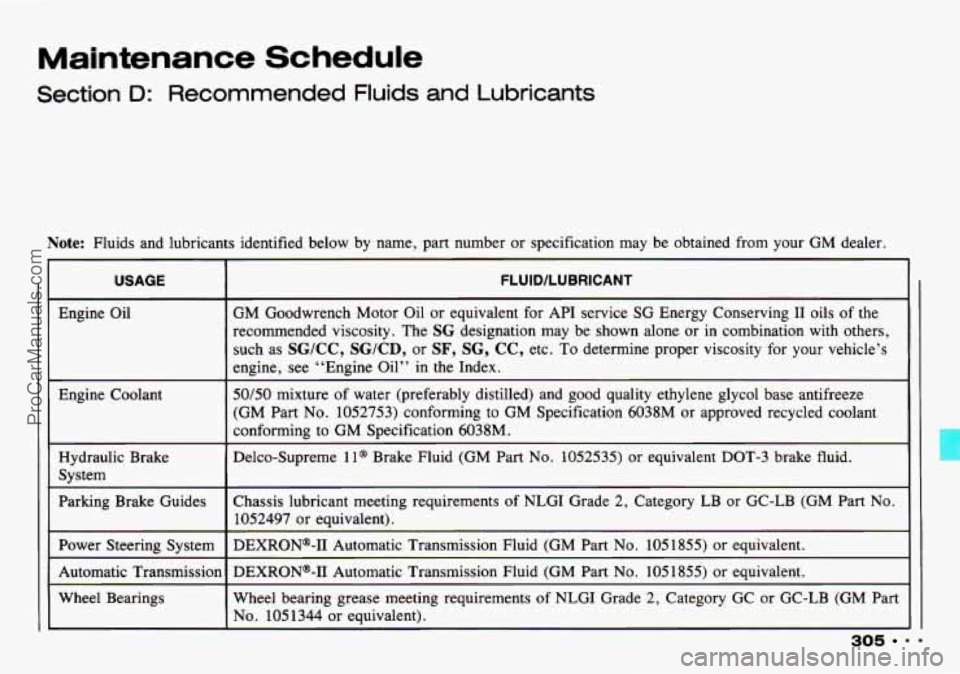
Maintenance Schedule
Section D: Recommended Fluids and Lubricants
Note: Fluids and lubricants identified below by name, part number or specification may be obtained from your GM dealer.
USAGE
Engine Oil
Engine Coolant
Hydraulic Brake
System
Parking Brake Guides
Power Steering System
Automatic Transmission
Wheel Bearings
FLUID/LUBRICANT
GM Goodwrench Motor Oil or equivalent for API service SG Energy Conserving I1 oils of the
recommended viscosity. The SG designation may be shown alone or in combination with others,
such as
SG/CC, SG/CD, or SF, SG, CC, etc. To determine proper viscosity for your vehicle’s
engine, see
‘ ‘Engine Oil” in the Index.
50/50 mixture of water (preferably distilled) and good quality ethylene glycol base antifreeze
(GM Part
No. 1052753) conforming to GM Specification 6038M or approved recycled coolant
conforming to GM Specification 6038M.
Delco-Supreme 1
l@ Brake Fluid (GM Part No. 1052535) or equivalent DOT-3 brake fluid.
~~
Chassis lubricant meeting requirements of NLGI Grade 2, Category LB or GC-LB (GM Part No.
1052497 or equivalent).
DEXRONB-I1 Automatic Transmission Fluid (GM Part
No. 1051855) or equivalent.
DEXRON*-I1 Automatic Transmission Fluid (GM Part
No. 1051855) or equivalent.
3.
-
-
305 9 -
Wheel bearing grease meeting requirements of NLGI Grade 2, Category GC or GC-LB (GM Part
No. 105 1344 or equivalent).
ProCarManuals.com
Page 328 of 339
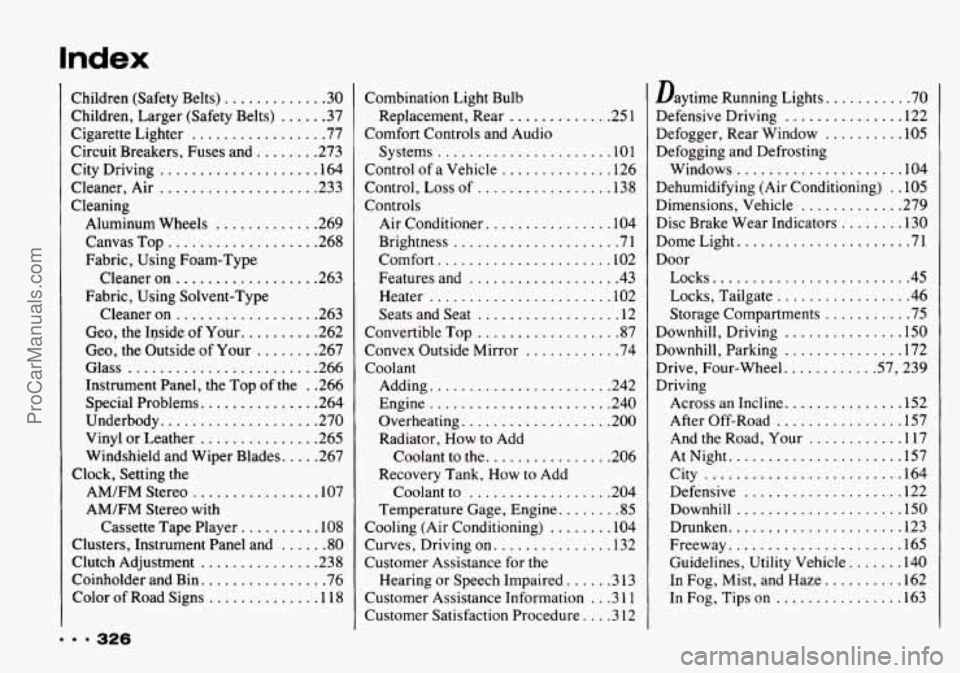
Index
Children (Safety Belts) ............. 30
Children. Larger (Safety Belts) ...... 37
Cigarette Lighter
................. 77
Circuit Breakers. Fuses and ........ 273
City Driving
.................... 164
Cleaner. Air
.................... 233
Cleaning Aluminum Wheels
............. 269
Canvas Top
................... 268
Fabric. Using Foam-Type
Cleaner on
.................. 263
Fabric. Using Solvent-Type
Cleaner on
.................. 263
Geo. the Iqside of Your
.......... 262
Geo. the Outside of Your
........ 267
Glass
........................ 266
Instrument Panel. the Top of
the . . 266
Special Problems
............... 264
Underbody
.................... 270
Vinyl or Leather
............... 265
Windshield and Wiper Blades
..... 267
AM/FM Stereo
................ 107
AM/FM Stereo with
Cassette Tape Player
.......... 108
Clusters. Instrument Panel and
...... 80
Clutch Adjustment
............... 238
Coinholder and Bin
................ 76
Color
of Road Signs .............. 1 18
Clock.
Setting the Combination Light Bulb
Replacement. Rear
............. 25 1
Comfort Controls and Audio
Systems
...................... 101
Control of a Vehicle
.............. 126
Control.
Loss of ................. 138
Controls
Air Conditioner
................ 104
Brightness ..................... 7 1
Comfort
...................... 102
Features and
................... 43
Heater
....................... 102
Seats and Seat
.................. 12
Convertible Top
.................. 87
Convex Outside Mirror
............ 74
Coolant
Adding
................ .... 242
Engine
....................... 240
Overheating
................... 200
Radiator, How to Add
Coolant to the
................ 206
Recovery Tank, How to Add
Coolant to
.................. 204
Temperature Gage. Engine
........ 85
Cooling (Air Conditioning) ........ 104
Curves, Driving on
............... 132
Customer Assistance for the
Hearing
or Speech Impaired ...... 3 13
Customer Assistance Information
... 3 11
Customer Satisfaction Procedure
.... 3 12 Daytime
Running Lights
........... 70
Defensive Driving
............... 122
Defogger. Rear Window
.......... 105
Defogging and Defrosting
Windows
..................... 104
Dehumidifying (Air Conditioning)
. . 105
Dimensions. Vehicle ............. 279
Disc Brake Wear Indicators
........ 130
Dome Light
...................... 71
Door Locks
......................... 45
Locks. Tailgate
................. 46
Storage Compartments
........... 75
Downhill. Driving
............... 150
Downhill. Parking ............... 172
Drive. Four-wheel
........... .57. 239
Driving
Across an Incline
............... 152
After Off-Road
................ 157
And the Road. Your
............ 117
AtNight
...................... 157
City
......................... 164
Defensive
.................... 122
Downhill
..................... 150
Drunken ...................... 123
Freeway
...................... 165
Guidelines.
Utility Vehicle ....... 140
In
Fog. Mist. and Haze .......... 162
In
Fog. Tips on ................ 163
... 326
ProCarManuals.com